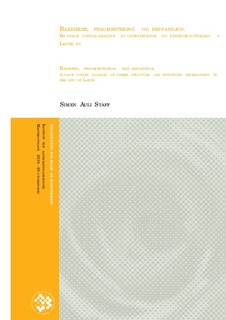| dc.description.abstract | Formålet med denne oppgaven er å undersøke om den planlagte sentrumsutviklingen i Larvik by vil bidra
til å skape et mer helhetlig og sammenhengende sentrum. Larviks industrialiserte sjøfront er planlagt
transformert til sentrumsformål, og sentrumssonen er justert i rulleringen av kommuneplanens arealdel, slik
at transformasjonsområdene inkluderes. Utviklingen av et helhetlig og sammenhengende sentrum avhenger
av å overkomme den barrieren jernbanelinjen utgjør mellom etablert sentrum og transformasjonsområdene.
Oppgaven fokuserer på konseptet som ligger til grunn for transformasjonen av Indre havn og den planlagte
gangforbindelsen mellom Bøkkerfjellet og Sanden, samt innflytelsen de eksterne sentrene Nordbyen og Øya har på sentrumsutviklingen i Larvik by.
Byens romlige sammenhenger analyseres ved hjelp av space syntax-metode, som tar utgangspunkt i at arealbruk og lokalisering av funksjoner i et bysentrum kan avledes fra fysiske sammenhenger i gate- og
vegstrukturen. Space syntax-analysen utføres for å besvare et sett med hypoteser om sammenhengene i dagens struktur og hvordan tenkte framtidige strukturer vil påvirke disse sammenhengene. Resultatene fra analysen av dagens struktur viser at nettverkets sentrum sammenfaller med den gamle sentrumssonen. Jeg fant også at hovedrutene i nettverket brytes i sentrum og at områdene sør for sentrum har svake forbindelser mot sjøfronten. Analysen av den tenkte strukturen i transformasjonsområdene viser også denne svakheten, dog noe redusert. Sjøfronten får sentrumskvaliteter og makter å forsere jernbanen, men tilnærmingen mot etablert sentrum hindres av den strukturelle barrieren som området mot sentrum utgjør. Hverken gangforbindelsen eller de eksterne sentrene virker inn på den romlige sammenhengen i Larvik sentrum
Etablering av sentrumsfunksjoner ved sjøfronten i Larvik innebærer ikke en forskyvning av sentrumsområdet, men en utvidelse. Den totale aktiviteten i et allerede presset sentrum vil dermed spres
på et betydelig område. Strukturene som forbinder etablert sentrum med sjøfronten må forbedres for at hele Larvik sentrum skal overleve. Alternativet er å flytte alle sentrumsfunksjoner ned mot sjøfronten
og transformere de gamle sentrumsområdene til boliger. Jeg tviler på om det er mulig for Larvik å både
transformere sjøfronten og samtidig beholde det gamle sentrum som det er.
The purpose of this study is to assess the contribution of the planned downtown development in the city of Larvik, to a more coherent and cohesive central business district (CBD). The city of Larvik is planning to transform its industrialised sea front, and the zone defining the CBD has been adjusted to include these
transformation areas. The development of a coherent and cohesive CBD relies on the ability to surmount the barrier formed by the railroad, between the current CBD and the transformation areas. The focus of this
study is on the fundamental concept behind the transformation of the sea front and on the planned footbridge between Bøkkerfjellet and Sanden, as well as on the influence the external centres Nordbyen and Øya have on the downtown development of the city of Larvik.
Larvik’s spatial patterns are analysed using space syntax, a method which supposes that urban land use and functions can be derived from patterns in the street structure. The space syntax analysis is conducted in order to answer a set of hypotheses concerning the patterns of Larvik’s present street structure and how future structures may affect these patterns. The results of the analysis the present patterns show that the central area of the network correlates with the former CBD-zone. I also found that the network’s main routes are disjoined in the current CBD, and that the CBD is poorly connected with the sea front. The analysis of the patterns of future structures also shows this poor connection, though to a slightly lesser extent. The sea front will have urban qualities and will surmount the railroad, but its approach toward the established CBD is
hampered by the structural barrier formed by the area between them. Neither the footbridge nor the external centres affect the spatial patterns of Larvik CBD. Establishing CBD functions at Larvik’s sea front does not constitute an adjustment of the CBD, but rather an expansion. The total level of activity in Larvik’s strained CBD will be spread over a substantial area. The
structures which connect the current CBD with the sea front require improvement to ensure the survival of downtown Larvik. The alternative is to move all the CBD functions to the sea front and transform the
current CBD into housing. I doubt whether it is possible for Larvik to develop a new CBD at the sea front, while keeping the old area as it is. | en_US |
